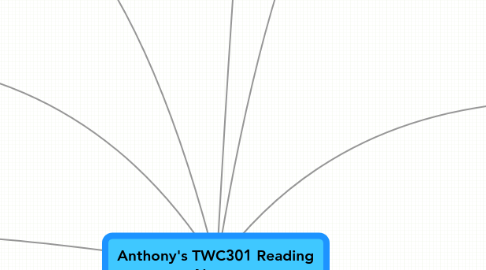
1. Document types
1.1. E-mail
1.2. Letters
1.3. Technical Definitions, descriptions, instructions.
1.4. Websites
1.5. Manuals
1.6. Proposals
1.7. Informal and Formal reports
1.8. Presentations
2. Problem Solving Approach
2.1. Plan
2.2. Research
2.3. Draft
2.4. Review
2.5. Distribute
3. Activities Involved in Technical and Professional Communication
3.1. Planning
3.1.1. HTW: Style
3.2. Designing
3.3. Editing
3.4. Researching
3.4.1. HTW: Research
3.5. Integration of Visuals
3.6. Testing
3.7. Organizing
3.8. Revising
3.9. Drafting
3.10. Rewriting
4. Characteristics of Technical and Professional Communication
4.1. Rhetorical
4.2. Audience Centered
4.3. Technology Oriented
4.4. Ethical
4.4.1. HTW: Ethics in Writing
4.5. Research Oriented
4.6. Design Centered
4.7. Concise
5. Rhetoric and Technical Communication (D#2.0 HW#2)
5.1. Workplace Problems
5.2. Rhetorical Problems
5.2.1. Exigency and Purpose
5.2.2. Audiences
5.2.2.1. Variety
5.2.2.2. Expectations
5.2.2.3. Use of Documents
5.2.3. Writers and Credibility
5.2.3.1. Correctness
5.2.3.2. Experience
5.2.3.3. Goodwill
5.2.3.4. Identification
5.2.3.5. Trust
5.2.4. Contexts and Constraints
5.2.5. Documents
6. Electronic Technologies (D#2.0 HW#3)
6.1. Impact of Technology
6.2. Progress
6.3. Creation of Documents
6.3.1. Word Processors
6.3.2. Presentation Software
6.3.3. Graphics and Imaging Software
6.3.4. Web-Authoring Software
6.3.5. Desktop Publishing Software
6.3.6. E-Learning Authoring Tools
6.3.7. Single-Sourcing Programs
6.4. Communications
6.4.1. Internet
6.4.2. World Wide Web
6.4.3. E-Mail
6.4.3.1. HTW: E-Mail
6.4.4. Ethics and E-Mail
6.4.5. Electronic Messaging
6.4.5.1. HTW: Instant Messenging
6.4.6. Videoconferencing
6.4.7. Groupware
6.4.8. HTW: Global Communication
6.5. Future of Writing and Technology
6.5.1. Wireless Technology
6.5.2. Bandwidth
6.5.3. Portability
6.5.4. Price
6.5.5. Transnationalism
7. Ethics (D#2.0 HW#4)
7.1. Ethics
7.1.1. Metaethics
7.1.2. Normative Ethics
7.1.3. Applied Ethics
7.2. Ethics and the Writer
7.3. Ethics and Laws
7.3.1. Liability
7.3.2. Enviromental
7.3.3. Patent
7.3.4. Copyright
7.3.5. Trademarks and Service Marks
7.3.6. Contracts
7.4. Honesty
7.5. Confidentiality
7.6. Ethics in Context
7.6.1. Situation and Perspective
7.6.2. Circulation
7.6.3. Revision and Editing
7.7. Ethics and Technology
7.7.1. E-Mail
7.7.2. Websites
7.7.3. Visuals
7.8. Environmental Ethics
7.9. Unethical Writing
7.9.1. Deception and Evasion
8. Transnational Communication (D#3.0 HW#3)
8.1. Culture
8.1.1. Language
8.1.1.1. Target Language
8.1.1.2. Official Languages
8.1.1.3. International English
8.1.1.4. Text Directionality
8.1.1.5. Writing Style
8.1.1.6. HTW: Varieties of English
8.1.2. Technology
8.1.2.1. Machine Translation
8.1.3. Education
8.1.3.1. Literacy
8.1.3.2. Knowledge
8.1.3.3. Learning Style
8.1.4. Politics and Law
8.1.5. Economics
8.1.6. Society
8.1.6.1. Age
8.1.6.2. Business Ettiquette
8.1.6.3. Family and Socialization
8.1.7. Religion
8.2. Stereotypes
8.2.1. Assumptions
8.2.2. Question
8.2.3. Translators
8.3. Enhancing Translation
8.3.1. Terminology
8.3.2. Clarity
8.3.3. Cultural and Rhetorical Differences
8.3.4. Design
8.4. Transnational Accommodation
8.4.1. Localization
8.4.1.1. Improved Sales
8.4.1.2. Overcome Differences
8.4.1.3. Overcome Resistance
8.4.1.4. Access to New Markets
8.4.2. Internationalization
8.4.3. Globalization
8.4.3.1. HTW: Global Graphics
8.4.4. Verbal Communication
8.5. Ethics
8.6. Guidelines for Transnational Communication
8.6.1. Write Clearly
8.6.2. Localize Writing
8.6.3. Account for Visual and Auditory Perceptions
8.7. HTW: Global Communication
9. Organization and Drafting (D#3.0 HW#4)
9.1. Pre-drafting Strategies
9.1.1. Confirm Purpose
9.1.2. Analyze the Audience
9.1.3. Gather Information
9.1.4. Develop Ideas
9.1.5. Organize the Information
9.1.5.1. Sequential
9.1.5.2. Chronological
9.1.5.3. Priority
9.1.5.4. General/Specific
9.1.5.5. Divsion
9.1.5.6. Classification
9.1.5.7. Cause and Effect
9.1.5.8. Comparison/Contrast
9.1.5.9. Spatial
9.1.5.10. HTW: Organization
9.1.6. Outline the Ideas
9.1.6.1. HTW: Outlining
9.2. Writing the Draft
9.2.1. Parts of the Document
9.2.1.1. Front Matter
9.2.1.2. Body
9.2.1.3. End Matter
9.2.2. Nonlinear Process
9.2.3. Drafting the Body
9.2.4. Drafting the Conclusion
9.2.5. Drafting the Introduction
9.2.6. HTW: Writing a Draft
